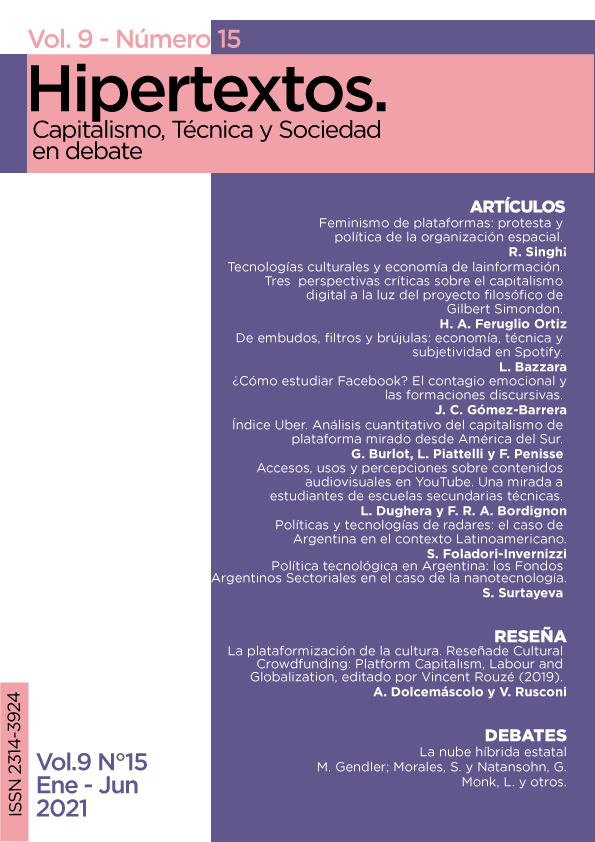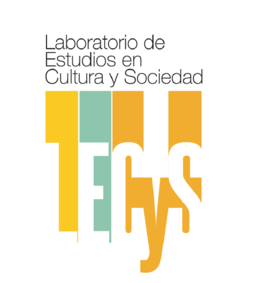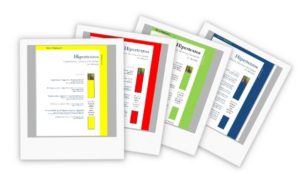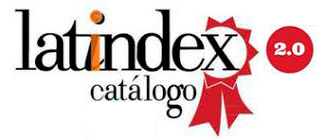¿Cómo estudiar Facebook?
El contagio emocional y las formaciones discursivas
DOI:
https://doi.org/10.24215/23143924e029Palabras clave:
Facebook, formaciones discursivas, contagio emocional, arqueología del saber, redes socialesResumen
Dado que las redes sociales digitales son un fenómeno relativamente nuevo y, sobre todo, cambiante, su abordaje requiere de la constante producción de herramientas metodológicas y analíticas. En esa dirección, el presente artículo muestra cómo se puede utilizar la noción teórico-metodológica de las formaciones discursivas para analizar las redes sociales, en este caso, un modo en el que opera Facebook. Esta noción, relativa a la arqueología del saber, permite entender a las redes sociales como resultados de convergencias discursivas y enunciativas. Este aporte teórico-metodológico está ejemplificado con el caso del contagio emocional y su convergencia con Facebook.
Referencias
Bakshy, Messing y Adamic (2015). Exposure to ideologically diverse news and opinion on Facebook. Science. Vol. 348. Pp. 1130-1132. DOI: 10.1126/science.aaa1160
Christakis N. y Fowler J. (2007). The spread of obesity in a large social network over 32 years. N Engl JMed 2007; 357:370-9.
Christakis N. y Fowler J. (2008). The collective dynamics of smoking in a large social network. N Engl JMed 2008; 358:2249-58.
Correa, J. C., García-Chitiva, M. D. P., & García-Vargas, G. R. (2018). A text mining approach to the text difficulty of Latin American peace agreement. Revista Latinoamericana de Psicología, 50(1), 61-70.
El Espectador, (06 oct. 2016), “La cuestionable estrategia de campaña del No”. El Espectador. https://www.elespectador.com/noticias/politica/cuestionable-estrategia-de-campana-del-no-articulo-658862
Foucault, M. (2011). La arqueología del saber. Buenos Aires: Siglo Veintiuno Editores.
Fowler, J. y Christakis, N. (2008a). Estimating peer effects on health in social networks. J Health Econ ; 27:1400-5.
Fowler, J. y Christakis, N. (2008b). Dynamic spread of happiness in a large social network: longitudinal analysis over 20 years in the Framingham Heart Study. BMJ. Doi: 10.1136/bmj.a.2338
Hatfield, Cacioppo y Rapson (1993). Emotional contagion. Curr Dir Psychol Sci 2(3): 96–100.
Hatfield, Cacioppo y Rapson (1994). Emotional contagion. NewYork: Cambridge University Press, 1994.
Hendricks, J. A. & Denton, R. (2010). Political campaigns and communicating with the electorate in the Twenty-First Century. En J. A. Hendricks & R. Denton (Eds.), Communicator-in-chief: How Barack Obama used new media technology to win the White House (pp. 1-18). Lanham: Lexington Books.
Kossinets G, Watts DJ. (2006). Empirical analysis of an evolving social network. Science; 311. pp. 88-90.
Kraft y Donovan (2020). Disinformation by Design: The Use of Evidence Collages and Platform Filtering in a Media Manipulation Campaign. Political Communication, 37. Pp. 194-214
Kramer, AD., Guillory J.E. y Hancock, J. (2014). Experimental evidence of massive-scale emotional contagion through social networks. PNAS (111-24).
Newman, M, (2003). The structure and function of complex networks. SIAM Rev Soc Ind Appl Math 2003; 45:167-256.
Nowak, M. y Sigmund, K. (2005). Evolution of indirect reciprocity. Nature; 437. Pp. 1291-8.
Papa A. y Bonanno, G. (2008). Smiling in the face of adversity: the interpersonal and intrapersonal functions of smiling. Emotion 2008;1:1-12.
Rader, G. (2015). Understanding User Beliefs About Algorithmic Curation in the Facebook News Feed. https://doi.org/10.1145/2702123.2702174
Rosenquist, Christakis y Fowler (2011). Social Network determinants of depression. Molecular Psychiatry. 16. Pág. 273-281.
Simondon, G. (2007). El modo de existencia de los objetos técnicos. Buenos Aires: Prometeo.
Steinert, S. (2020). Corona and value change. The role of social media and emotional contagion. Ethics and Information Technology. https://doi.org/10.1007/s10676-020-09545-z
Sun, E., Rosenn, I., Marlow, C. y Lento, T. (2009). Gesundheit! Modeling Contagion through Facebook News Feed. Association for the Advantacement of Artificial Intelligence. https://www.aaai.org/ocs/index.php/ICWSM/09/paper/view/185/428
Surakka, V.y Hietanen, J. (1998). Facial and emotional reactions to Duchenne and non-Duchenne smiles. Int J Psychophysiol; 29. Pp. 23-33.
Vaccari, C. (2010). Technology is a commodity: the Internet in the 2008 United States presidential election. Journal of Information Technology & Politics, 7, 318-339.
Zajonc, R. (1985). Emotion and facial efference: an ignored theory reclaimed. Science ;5. Pp. 15-21.

























